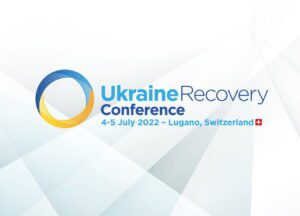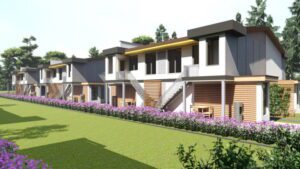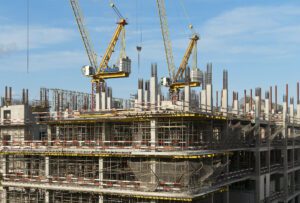
Ukrainian industry is one of the sectors of the economy most affected by the war. Since February 24, many large enterprises, primarily in the east and south of the country, have lost their production capacities, and the staff was forced to evacuate. At the same time, individual production facilities were transferred to the western regions, where they are being restored on the basis of more modern industrial facilities, such as industrial parks that appeared shortly before the war.
The Open4business portal spoke about the future of Ukrainian industry and the prospects for the restoration of production with Igor Stakovychenko, an expert in the field of economics.
According to the expert, the production of goods with high added value should become a priority for the development of the economy for decades to come.
“Before the aggression, our industry worked mainly according to standards that were not particularly modernized in 30 years of independence. This is the so-called canonical model, when you have raw materials, workshops, shipping, logistics, and so on. And there must also be stable consumers who will always buy products. Many plants with such a system failed the market test and closed down. Mostly giants remained, who more or less adapted. After the war, it will definitely not be possible to rebuild production in the same form, a fundamentally new model is needed, ”Igor Stakovichenko is sure.
The expert noted that in the modern world, the modernization of production involves the introduction of new management methods, as well as the creation of more adaptive sites, such as industrial zones or parks.
“If you have a workshop for the production of one specific part, which is itself part of a complex and long chain for creating the final product, then the situation above is rather precarious in modern conditions since you depend on many factors: suppliers, market situation, current conjuncture. If you have, for example, a 3D printer that can produce any shape to order for a specific client, then the situation is more stable for you, since you can quickly reorient yourself when the market changes. In the modern world, the industry is striving for greater universalization,” explained Igor Stakovichenko.
According to him, the restoration of the industry should begin now and be based, firstly, on the creation of industrial parks in safe regions, and secondly, on the modernization of existing industries for new models. As an example, Stakovichenko cites the development of this concept in Poland or the Czech Republic, where industrial zones already provide up to 50% of GDP.
“The government is now acting in the right direction, providing tax incentives to such industrial zones, this will lay the foundation for the rapid restoration of the country’s industrial potential in the post-war period,” Stakovichenko summed up.
ECONOMY, IGOR STAKOVICHENKO, INDUSTRY, MARKETS, PRODUCTION, STAKOVICHENKO

Yesterday, the Cabinet of Ministers included the pharmaceutical industry in the list of priority sectors of the economy, thereby strengthening state support in this area. Since the beginning of the war, the main pharmaceutical companies in Ukraine have generally maintained their production capacities, while several enterprises suffered as a result of Russian strikes, in particular, in March, the warehouses of the Farmak pharmaceutical plant burned down in Makarov, Kyiv region. The damage then, according to the enterprise, amounted to about 1.5 billion hryvnia.
How important is state support for pharmaceutical manufacturers now, and will the industry be able to provide Ukrainians with medicines in full? Igor Stakovichenko, an expert in the field of economics, answered these and other questions for the Open4business portal.
In his opinion, now the production of medicines should be equated by the state with the provision of the army, since in a warring state medicine is one of the foundations of a stable situation at the front and in the rear.
“It is hard to imagine that the army will be able to fight effectively if it is not provided with high-level medical support. At the same time, the production of its own medications is strategically important for the state. Supplies from Western partners are good, but having your own working pharmaceutical industry in such a difficult time is much better And this is understood in the government,” Igor Stakovichenko believes.
According to the expert, pharmaceutical production in Ukraine today is able to provide both the army and the population with a significant part of the necessary medicines. Igor Stakovichenko believes that the government’s timely decisions taken since the beginning of the war made it possible to quickly adapt the industry to new conditions.
“In particular, back in the spring, amendments were adopted to the law “On Medicines”, limiting the export of certain vital drugs. In addition, they significantly simplified the registration of pharmaceuticals during the war, creating an emergency procedure. This was done literally on the third day. In general, the government’s decision on The inclusion of pharmaceutical production in the list of priority industries is a continuation of the policy of supporting the industry, which has been outlined since the beginning of the war. Such support should remain at the level of the main state priorities,” stressed Igor Stakovichenko.
ECONOMY, MARKETS, MEDICINE, PHARMA, STAKOVICHENKO, ИГОРЬ_СТАКОВИЧЕНКО

On July 4, an international conference for the restoration of Ukraine started in Lugano, Switzerland. Among the main decisions taken on the first day of the conference, one can single out the approval of a plan to provide Ukraine with macro-financial assistance in the amount of $750 billion. Of this total, from 150 to 250 billion is expected to be directed to the restoration of infrastructure and housing damaged as a result of hostilities.
At the same time, the mechanisms for the practical implementation of this project remain unclear in the context of the ongoing war and the need to adapt legislation to it and establish partnerships between the state and private companies. Portal Open4business turned to Igor Stakovychenko, an expert in the field of construction and real estate, for a comment.
In his opinion, the practical implementation of the project should be started now at all levels, since delaying the process can lead to negative consequences in the autumn-winter period.
“Mechanisms for allocating funds from the confiscated assets of the Russian Federation and its large businesses are already being implemented by individual countries. We, in turn, need to implement the conversion of these financial assets into specific infrastructure and construction projects by creating representative offices in donor countries and coordination centers in Ukraine,” said Ihor Stakovychenko.
The expert also stressed that the regional principle of recovery, now promoted by the country’s leadership, when a separate partner state is engaged in projects in a separate Ukrainian region, is the most effective at this stage.
In addition, Igor Stakovychenko suggested creating a system of decentralized funding for the implementation of individual projects at the local level.
“But we must not forget about our responsibility to our partners. It is necessary not only to minimize, but to completely exclude the possibility of misuse of foreign aid by local officials. To do this, it is necessary to create a separate trust fund for each individual restoration project, the activities of which will be as transparent and controlled as possible by both the Ukrainian anti-corruption authorities and the donor country,” Ihor Stakovychenko emphasized.
According to the expert, the basis for the creation of such funds should be existing budget programs, as well as amendments to the main financial document.
“In fact, now we can receive funds both in the form of direct assistance and in the form of investments from partners. Here it is important to successfully implement and present the first major restoration projects, which will help increase investment attractiveness even in the current conditions,” added Igor Stakovychenko.
CONSTRUCTION, EXPERT, FINANCE, MARKETS, REAL ESTATE, RESTORATION_OF_UKRAINE, TECHNOLOGY, ІГОР_СТАКОВИЧЕНКО, СТАКОВИЧЕНКО

On July 1, the “Register of Destruction” is launched in Ukraine. With its help, homeowners whose houses and apartments were damaged as a result of hostilities and enemy shelling will be able to apply for compensation using the Diya application.
At the same time, the question of what the restored houses of Ukrainians will be like, taking into account the new realities and requirements for the housing stock after the war, remains no less important. The Open4business portal discussed these issues with Igor Stakovichenko, an expert in the field of construction and real estate.
“The introduction of the “Register of Destruction” will greatly simplify the procedure for compensating for damages for affected citizens. In fact, such a registry will bring together all the data on the destruction in the country. This will be very useful both for the state of Ukraine and for individual citizens when receiving compensation from the aggressor through international legal institutions,” the expert noted.
As for the new technologies that will be used in the construction of housing, here Stakovichenko recommends first of all to focus on the needs of society.
“What most people want from a new home, whose homes have been destroyed by the war, is reliability and security. The presence of equipped bomb shelters, convenient evacuation routes, autonomy – these are the criteria without which it is difficult to imagine post-war architecture,” Igor Stakovichenko stressed.
In his opinion, a good option would be the restoration and development of numerous recreational areas, some of which were abandoned even before the war. Stakovichenko believes that many Soviet-built sanatoriums and boarding houses, which have been practically not used for all the years of independence, can become a good platform for building eco-friendly settlements with autonomous service, since most of the communications have already been connected to them.
“Environmental friendliness and high technologies during construction will also become the hallmark of post-war architecture in Ukraine. Projects such as “zero energy houses”, or even “mini-power houses”, which are now being widely implemented in the EU, will also be popular after the war,” the expert added.
At the same time, Igor Stakovichenko sees no special prospects for aggressive development in the central areas of large cities, which was practiced before the war.
“Multi-apartment residential complexes in large cities will certainly continue to be built, but whether there is a buyer for such housing is already a question. I think many have already revised or will reconsider their views on comfortable housing as a result of the war,” the expert concluded.
CONSTRUCTION, EXPERT, FINANCY, IGOR STAKOVYCHENKO, MARKETS, REAL ESTATE, TECHNOLOGY, СТАКОВИЧЕНКО

The war caused and continues to cause significant damage to the economy of Ukraine. Today, perhaps, the construction and real estate markets suffered the most from the hostilities. Thus, the report of the National Bank of Ukraine “On Financial Stability” dated June 17, 2022 indicates that since the beginning of the war, the market has practically stopped, both in terms of construction and the sale of housing. At the same time, according to the NBU, the situation has begun to level off in recent weeks, and above all in the regions that are least affected by the destruction from the war.

The most favorable situation is in the western regions of the country, while the National Bank notes that a number of significant problems remain there. First of all, this is a market imbalance, when the prices declared by sellers are not supported by demand and are supported artificially.
As for construction, here, according to the regulator, the situation is more optimistic. Developers have restored work on almost 50% of the facilities in the country. The most positive dynamics is observed in the western regions, in the center and in the Odessa region.

As for the office real estate market, according to the NBU, it suffered to a greater extent from the massive transition of staff to remote work.
The Open4business portal asked financial expert Igor Stakovichenko to comment on the current situation. In his opinion, the severity of the crisis in the real estate market directly depends primarily on the intensity of hostilities in various regions of the country, as well as on the well-being of the population.
“We see that the demand for housing in the same Kharkiv and Dnipro collapsed almost equally. At the same time, housing construction in Kharkiv is at a standstill, while in Dnipro it is being restored. This is due to the risk assessment by developers, since the Kharkiv region is now under devastating shelling by the aggressor,” the expert believes.
In his opinion, most of the prices in both the primary and secondary markets are dictated by the overestimated expectations of developers who continue to hope to find a buyer for their goods despite changes in the economy and a decrease in the income of part of the population.
“Builders think in the old way, and form the price based on the cost and those mark-ups that were fair in the pre-war period. Buyers have become much more cautious and assess the risks, in particular, the presence of bomb shelters, evacuation routes, and so on. As for the secondary market, here prices are often drawn from the ceiling, hoping more for luck, ”said Stakovichenko.
According to the expert, market recovery can be expected after the end of the war, when the demand for housing will increase and investors’ fears will decrease.
CONSTRUCTION, EXPERT, FINANCY, IGOR STAKOVICHENKO, MARKETS, REAL ESTATE MARKET, STAKOVICHENKO

Activity of international and Ukrainian retailers has revived attention of developers to building retail real estate in all large cities of Ukraine, UTG consulting company (Kyiv) has told Interfax-Ukraine. “The decline in consumer confidence in Europe, the rapid development of online commerce, the high level of competition in the clothing and footwear segment, the growth of staff salaries led to a decrease in profit margins and a pile of inventory at the largest European retailers, forced them to look for new markets, stimulated exit and the opening of stores in markets of countries not previously covered,” Head of Strategic Consulting at UTG Kostiantyn Oliynyk said.
So, after many years of negotiations, the leading international retailers presented earlier in the country began to return to the national market of Ukraine: H&M, Decathlon, Koton, Defacto, Polo Ralph Lauren, Kilian, AllSaints, PennyBlack, Tru Trussardi, Laurel, XTI, Santoni, Jo Malone, Daniel Hechter and others.
According to him, by the end of 2019, at the various stages of implementation (construction, preparatory work, concept) in Kyiv and the nearest suburbs there are 44 projects with a total rental area of 1.46 million square meters, in Odesa – 15 projects with a total rental area of 419,400 square meters, in the Dnipro – more than 100,000 square meters, in Kharkiv – more than 124,000 square meters, in Lviv – more than 80,000 square meters.
At the same time, the purchasing power and potential of retail space is limited by the size of salaries (in Kyiv – UAH 16,249; in Odesa – UAH 9,473; in Kharkiv – UAH 9,453, in Lviv – UAH 9,729), the pace of their growth, and the size of consumer expenses (in Kyiv – 62.2% of total family income; in Odesa – 67.6%; in Kharkiv – 62.9%, in Lviv – 71.80%) and the growth of the cost of housing and utility services, maintenance/rental of housing, travel, transportation, communication, education, medicine, as well as the level of inflation and the exchange rate of the national currency.
In addition, the success and functioning of retail real estate is significantly influenced by the volume and structure of the existing supply. So, in Kyiv there are five regional, 27 district, 24 micro-district, 19 specialized and 32 separate hypermarkets with a total area of just over 1.6 million square meters. The current offer of Odesa is 449,100 square meters, Kharkiv – 503,400 square meters, and Lviv – 399,100 square meters.
At the same time, the retail real estate offer is constantly increasing. In 2019 alone, the Smart Plaza Obolon micro district shopping centers (GLA is 11,800 square meters) and the Oasis shopping center (GLA is 7,800 square meters) were opened in Kyiv, and the regional River Mall (GLA is 62,200 square meters) and Blockbuster Mall (GLA is 135,000 square meters), the Araks specialized center in Khodosivka (GLA is 10,000 square meters) and street retail located at 2, Kyrpy Street (GLA is 2,500 square meters).
In addition, on December 7, the Karavan Outlet updated shopping center (GLA is 45,300 square meters) was announced for opening after restyling and reconstruction.
“As a result, in the case of the implementation and commissioning of all declared large-scale projects in local markets, a surplus of retail space may occur, which will entail a redistribution of consumer flows between facilities, an increase in vacancy and a correction in rental rates downward, especially in obsolete facilities with serious conceptual flaws,” Oliynyk said.
In his opinion, the approach of saturation and changes in the market are already becoming noticeable, and some developers have begun comprehensive modernization, redevelopment, specialization, or restyling of their retail facilities. For example, such facilities as Karavan, Metrograd, Silver Breeze, InSilver, Lukianivka Kvadrat, Gorodok, Magellan, Marmalade, Dream Town and Sirius started the update. In addition, Oliynyk said that a number of owners of the malls plan large-scale changes in the near future.